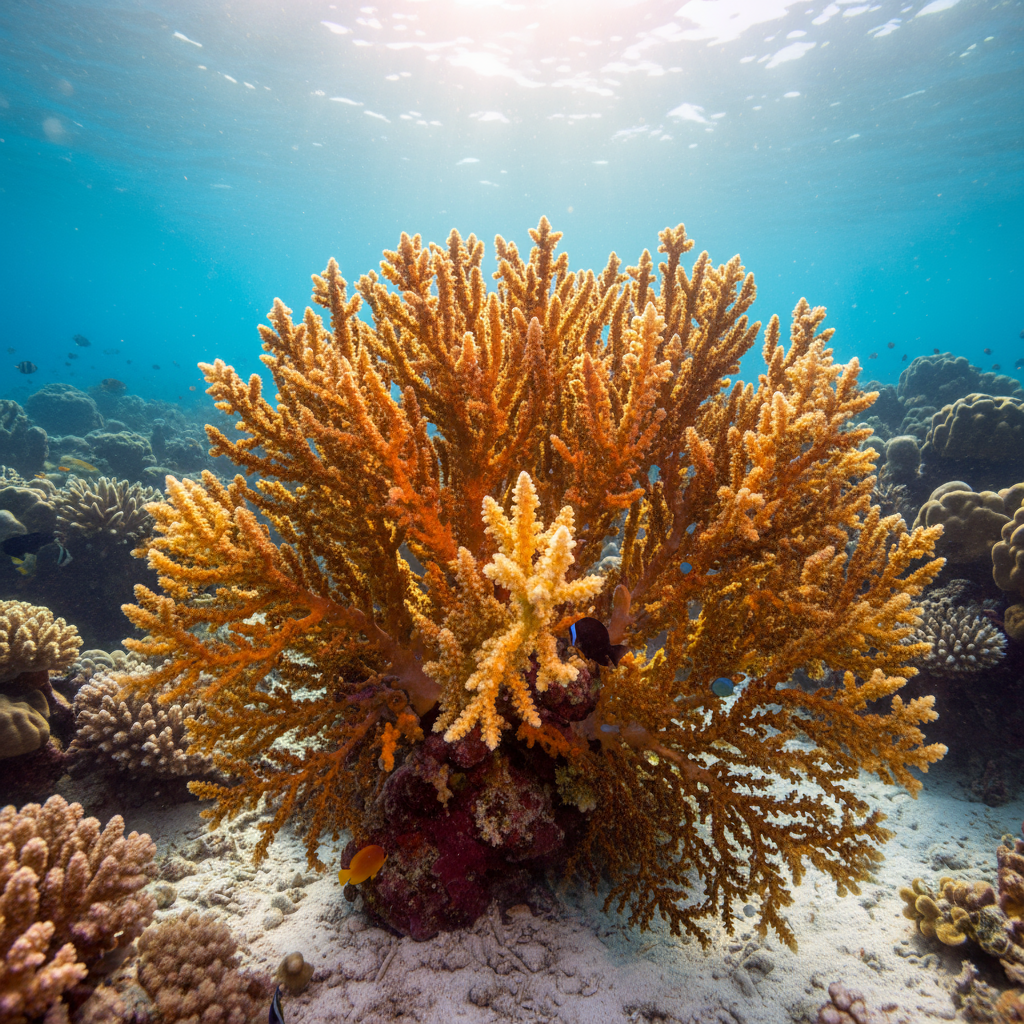Millepora (Stinging Coral): Classification, Habitat, Characteristics, and Importance
Classification of Millepora (Stinging Coral)
- Kingdom: Animalia — Multicellular, heterotrophic organisms with complex cellular structure
- Phylum: Cnidaria — Aquatic animals characterized by radial symmetry and cnidocytes (stinging cells)
- Class: Hydrozoa — Mostly colonial, small aquatic animals with polyp and medusa life stages
- Order: Anthoathecata — Hydroids with athecate (unprotected) polyps
- Family: Milleporidae — Hydrocorals known for calcareous skeletons and potent stinging cells
- Genus: Millepora — Colonial fire corals with branching or sheet-like calcareous exoskeletons

Habit and Habitat
Marine form, found associated with coral reefs in tropical seas. It is colonial hydroid with much branched hydrorhiza.
Millepora, commonly known as fire coral, is a genus of colonial marine hydrozoans mostly inhabiting tropical and subtropical coral reefs. Unlike true corals (Anthozoa), They belongs to the class Hydrozoa and is closely related to jellyfish and jelly-like animals. Fire corals form stiff, branching, plate-like or encrusting colonies fixed firmly on reef structures.
They thrive in shallow, well-lit waters typically from 1 to 40 meters deep, favoring reef crests, slopes, and lagoons with strong water movement. These colonial organisms contribute significantly to reef structure by secreting calcium carbonate skeletons, forming vital habitat for numerous marine species.
Geographical Distribution
Millepora is widely distributed in tropical and subtropical marine waters across the Atlantic, Indo-Pacific, and Caribbean regions. Prominent populations occur in the Caribbean Sea, Gulf of Mexico, Florida Keys, Indian Ocean, and Pacific Ocean coral reefs.
This wide distribution underlines its ecological importance as a reef-building organism and its adaptability to diverse oceanic conditions like temperature, light, and current regimes.

General Characteristics
- Commonly called as stinging coral.
- Colony varies in form, consisting of a broad basal mass which is incrusted on the rocks and from which short irregular branches are thrown into the water. Ectoderm secretes a large skeleton of perisarc, resembling corals perforated by numerous pores.
- Dried colony of lime carbonate contains pores of two types: (i) gastropores or larger pores, through which gastrozooids protrude in lifetime. (ii) dactylopores or smaller pores are found around gastropores, through which dactylozooids come out. Gastropores and dactylopores randomly distributed.
- Gastrozooids are feeding zooids, having 4 to 5 short knobbed tentacles and dactylozooids, with capitate tentacles having nematocysts, are protective zooids.
- Pores lead into a canal which forms network in coenosarc. Medusae with 4 or 5 rudimentary tentacles are free, simple and originate from coenosarc.
- Dried colony forms irregular mass.
- Colonial hydrozoans with calcareous exoskeletons which provide rigidity and reef-building capability.
- Colonies appear as branching, plate-like, or sheet-like forms with surface covered in tiny polyps.
- Possess two types of polyps: Gastrozooids for feeding and dactylozooids specialized for defense.
- Dactylozooids bear numerous nematocysts responsible for potent stinging ability termed fire coral sting.
- Exhibit vibrant colors ranging from yellowish, brown to greenish hues due to presence of symbiotic zooxanthellae (photosynthetic algae).
- Obtain energy both heterotrophically (preying on plankton) and autotrophically via symbiosis with zooxanthellae.
- Reproduce asexually by budding and sexually through production of medusoid larvae which develop into new colonies.
Special Features
- It is called as stinging coral because its powerful nematocysts are painful to man. Due to the presence of numerous pores, it is called as Millepora.
- Fire coral’s stinging cells can cause painful stings to humans and predators, acting as efficient defense.
- The calcium carbonate skeletons produced by Millepora contribute extensively to coral reef formation and maintenance.
- Exhibits remarkable regenerative ability, enabling colonies to recover from physical damage due to storms or predation.
- Symbiotic relationship with zooxanthellae boosts their energy efficiency and reef productivity.
- Fire coral stings are medically significant; they can cause burning pain, dermatitis, and occasionally severe allergic reactions in humans.
Identification
The specimen has random distribution of gastropore and dactylopores and all above characters, hence it is Millepora.
They can be identified in the field by its characteristic branching or sheet-like coral colonies with rough, porous surfaces and numerous tiny polyps. The presence of dactylozooids with fine peripheral hairs is visible upon close inspection.
Coloration varying from yellow, brown, green to pale tones also helps distinguish Millepora from true corals. Their habitat on exposed reef crests and slopes with high water movement is also indicative.

Ecological Importance
Millepora plays a crucial role in coral reef ecosystems by contributing to reef framework, providing habitat and shelter to numerous marine organisms including fish, invertebrates, and algae. Their stinging ability deters predators, maintaining the colony’s integrity and promoting reef biodiversity.
Fire corals serve as bioindicators of reef health, sensitive to environmental changes like pollution, temperature stress, and ocean acidification. Their successful growth indicates favorable water quality and ecosystem status.
Medical and Human Relevance
Though beneficial ecologically, contact with Millepora has negative implications for humans due to its painful sting. Divers, snorkelers, and fishermen are often at risk of fire coral stings which produce immediate burning sensation followed by redness, swelling, and sometimes blistering.
Treatment involves thorough irrigation with saltwater, removal of nematocysts, and symptomatic care with analgesics and antihistamines. Understanding fire coral biology helps lessen human injuries and promote safer reef tourism.
Research and Conservation
Millepora has been extensively studied for toxin composition, regenerative mechanisms, and symbiotic associations. Its venom contains bioactive proteins studied for potential pharmaceutical applications.
Conservation of Millepora is imperative amidst global coral reef decline driven by climate change, ocean acidification, and anthropogenic pollution. Protection through marine protected areas, sustainable tourism, and pollution control is critical for preserving these vital reef builders.
References
- https://www.sciencedirect.com/science/article/pii/S295019972500031X
- https://www.sciencedirect.com/science/article/abs/pii/S1080603218301194
- https://pubmed.ncbi.nlm.nih.gov/30236886/
- https://journals.sagepub.com/doi/full/10.1016/j.wem.2018.06.012
- https://www.scup.com/doi/10.18261/let.55.2.3
- https://en.wikipedia.org/wiki/Millepora_alcicornis
- https://animaldiversity.org/accounts/Acropora_millepora/
- https://www.nature.com/articles/s41598-019-50744-6
- https://www.britannica.com/animal/millepore
- https://www.sciencedirect.com/science/article/abs/pii/S0065288105500014
- https://en.wikipedia.org/wiki/Fire_coral
- https://animaldiversity.org/accounts/Millepora/classification/
- https://pubmed.ncbi.nlm.nih.gov/16782450/
- http://www.marinespecies.org/aphia.php?p=taxdetails&id=205902
- https://sta.uwi.edu/fst/lifesciences/sites/default/files/lifesciences/documents/ogatt/Millepora_alcicornis%20-%20Branching%20Fire%20Coral.pdf
- https://www.inaturalist.org/taxa/89967-Millepora
- https://animaldiversity.org/accounts/Millepora_alcicornis/
- http://www.marinespecies.org/aphia.php?p=taxdetails&id=210728
- https://explorer.natureserve.org/Taxon/ELEMENT_GLOBAL.2.119333/Millepora_alcicornis
